HRM strategies, recruitment effectiveness at Marks & Spencer analysis.
VerifiedAdded on 2022/12/28
|14
|5013
|219
Report
AI Summary
This report provides an in-depth analysis of Human Resource Management (HRM) practices within Marks and Spencer, a leading British multinational retailer. It examines the critical roles of HR functions in organizational success, including training and development, workplace planning, talent management, and organizational design. The report assesses the effectiveness of Marks and Spencer's recruitment and selection strategies in maintaining organizational performance, focusing on compliance with the Equality Act 2010. It further explores approaches to talent management and staff development and their impact on employee performance. Finally, the report investigates how HR systems and procedures enable the achievement of business objectives, highlighting the importance of HR as a strategic partner in driving organizational growth and success. Desklib offers more resources for students seeking solved assignments and past papers.
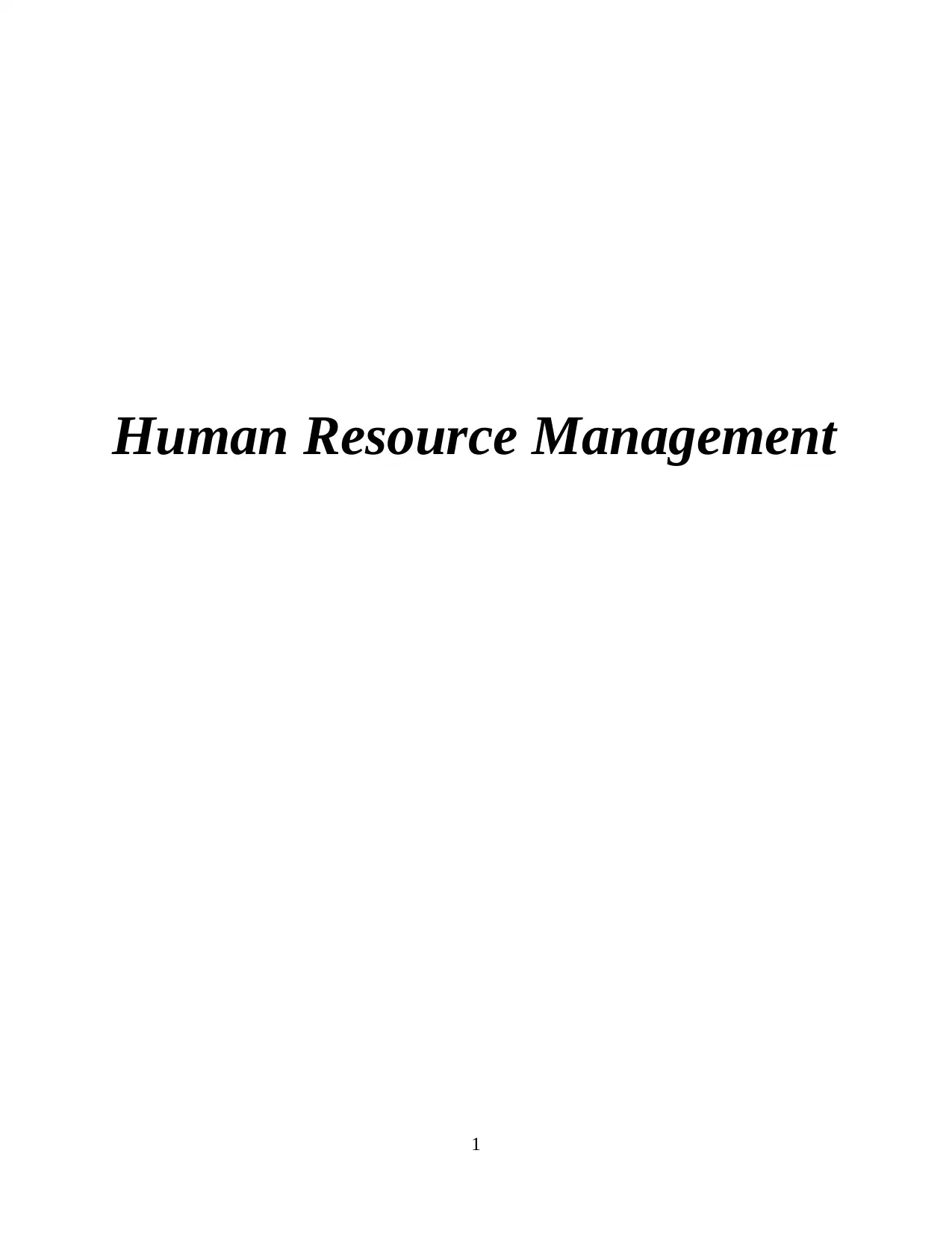
Human Resource Management
1
1
Paraphrase This Document
Need a fresh take? Get an instant paraphrase of this document with our AI Paraphraser
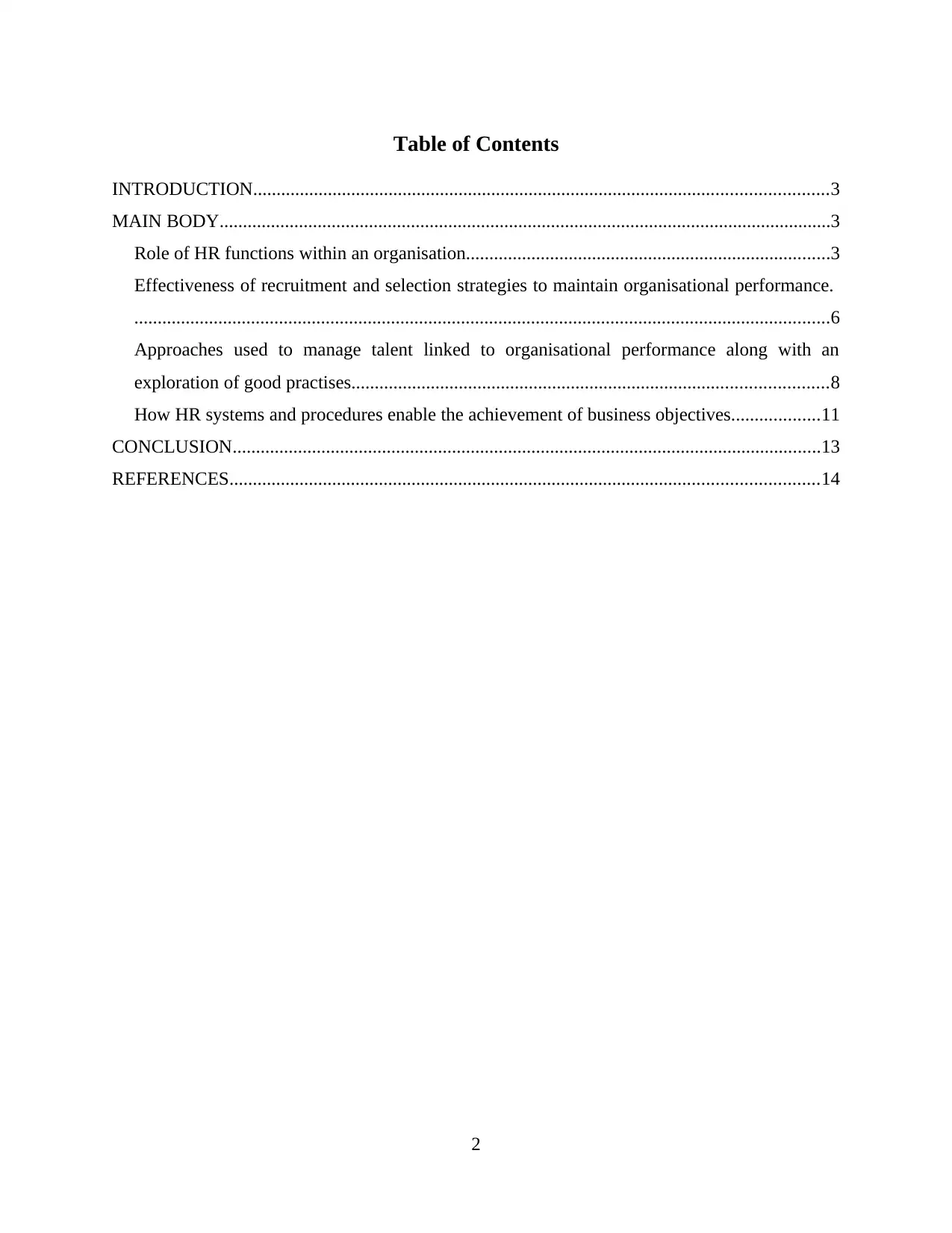
Table of Contents
INTRODUCTION...........................................................................................................................3
MAIN BODY...................................................................................................................................3
Role of HR functions within an organisation..............................................................................3
Effectiveness of recruitment and selection strategies to maintain organisational performance.
.....................................................................................................................................................6
Approaches used to manage talent linked to organisational performance along with an
exploration of good practises......................................................................................................8
How HR systems and procedures enable the achievement of business objectives...................11
CONCLUSION..............................................................................................................................13
REFERENCES..............................................................................................................................14
2
INTRODUCTION...........................................................................................................................3
MAIN BODY...................................................................................................................................3
Role of HR functions within an organisation..............................................................................3
Effectiveness of recruitment and selection strategies to maintain organisational performance.
.....................................................................................................................................................6
Approaches used to manage talent linked to organisational performance along with an
exploration of good practises......................................................................................................8
How HR systems and procedures enable the achievement of business objectives...................11
CONCLUSION..............................................................................................................................13
REFERENCES..............................................................................................................................14
2
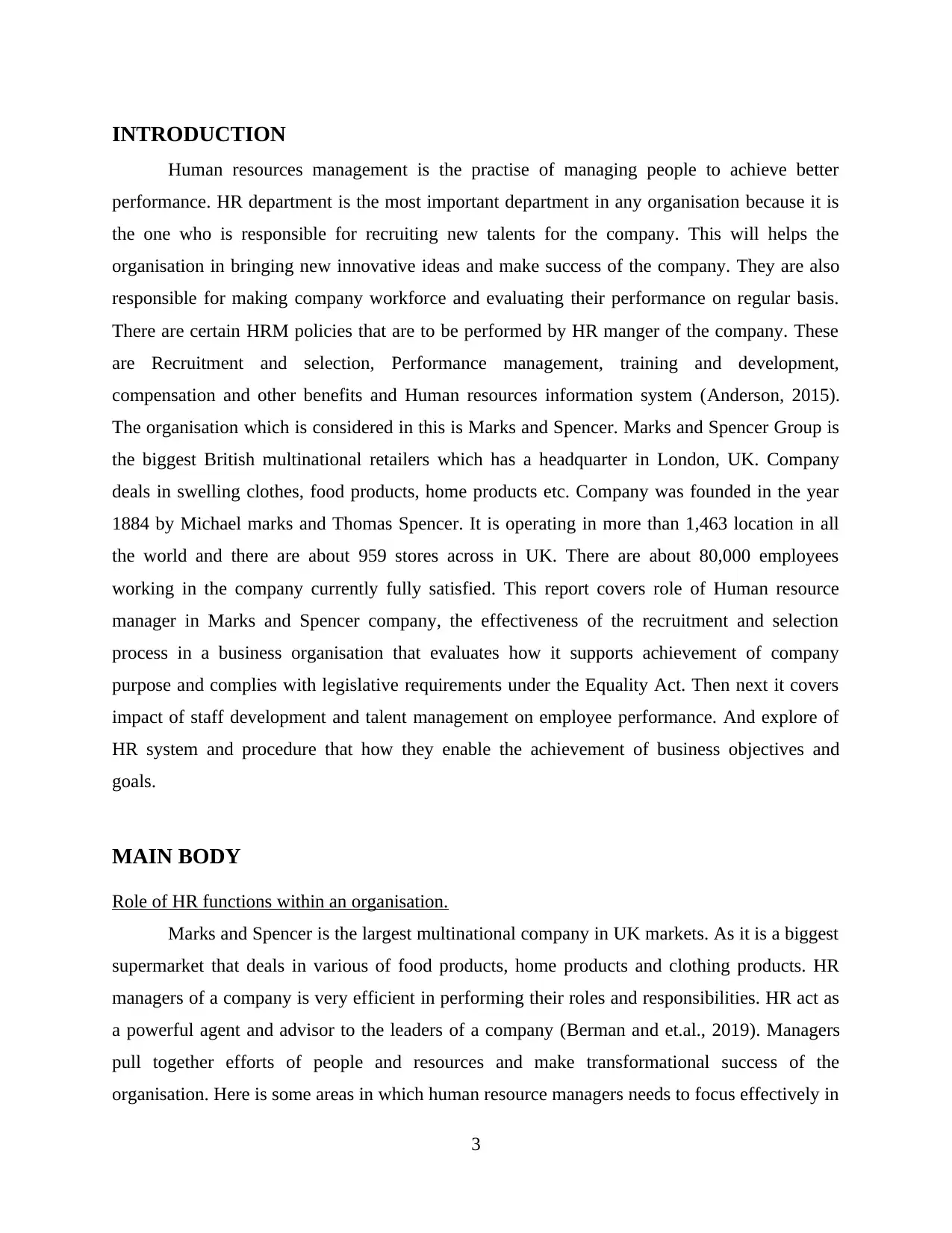
INTRODUCTION
Human resources management is the practise of managing people to achieve better
performance. HR department is the most important department in any organisation because it is
the one who is responsible for recruiting new talents for the company. This will helps the
organisation in bringing new innovative ideas and make success of the company. They are also
responsible for making company workforce and evaluating their performance on regular basis.
There are certain HRM policies that are to be performed by HR manger of the company. These
are Recruitment and selection, Performance management, training and development,
compensation and other benefits and Human resources information system (Anderson, 2015).
The organisation which is considered in this is Marks and Spencer. Marks and Spencer Group is
the biggest British multinational retailers which has a headquarter in London, UK. Company
deals in swelling clothes, food products, home products etc. Company was founded in the year
1884 by Michael marks and Thomas Spencer. It is operating in more than 1,463 location in all
the world and there are about 959 stores across in UK. There are about 80,000 employees
working in the company currently fully satisfied. This report covers role of Human resource
manager in Marks and Spencer company, the effectiveness of the recruitment and selection
process in a business organisation that evaluates how it supports achievement of company
purpose and complies with legislative requirements under the Equality Act. Then next it covers
impact of staff development and talent management on employee performance. And explore of
HR system and procedure that how they enable the achievement of business objectives and
goals.
MAIN BODY
Role of HR functions within an organisation.
Marks and Spencer is the largest multinational company in UK markets. As it is a biggest
supermarket that deals in various of food products, home products and clothing products. HR
managers of a company is very efficient in performing their roles and responsibilities. HR act as
a powerful agent and advisor to the leaders of a company (Berman and et.al., 2019). Managers
pull together efforts of people and resources and make transformational success of the
organisation. Here is some areas in which human resource managers needs to focus effectively in
3
Human resources management is the practise of managing people to achieve better
performance. HR department is the most important department in any organisation because it is
the one who is responsible for recruiting new talents for the company. This will helps the
organisation in bringing new innovative ideas and make success of the company. They are also
responsible for making company workforce and evaluating their performance on regular basis.
There are certain HRM policies that are to be performed by HR manger of the company. These
are Recruitment and selection, Performance management, training and development,
compensation and other benefits and Human resources information system (Anderson, 2015).
The organisation which is considered in this is Marks and Spencer. Marks and Spencer Group is
the biggest British multinational retailers which has a headquarter in London, UK. Company
deals in swelling clothes, food products, home products etc. Company was founded in the year
1884 by Michael marks and Thomas Spencer. It is operating in more than 1,463 location in all
the world and there are about 959 stores across in UK. There are about 80,000 employees
working in the company currently fully satisfied. This report covers role of Human resource
manager in Marks and Spencer company, the effectiveness of the recruitment and selection
process in a business organisation that evaluates how it supports achievement of company
purpose and complies with legislative requirements under the Equality Act. Then next it covers
impact of staff development and talent management on employee performance. And explore of
HR system and procedure that how they enable the achievement of business objectives and
goals.
MAIN BODY
Role of HR functions within an organisation.
Marks and Spencer is the largest multinational company in UK markets. As it is a biggest
supermarket that deals in various of food products, home products and clothing products. HR
managers of a company is very efficient in performing their roles and responsibilities. HR act as
a powerful agent and advisor to the leaders of a company (Berman and et.al., 2019). Managers
pull together efforts of people and resources and make transformational success of the
organisation. Here is some areas in which human resource managers needs to focus effectively in
3
⊘ This is a preview!⊘
Do you want full access?
Subscribe today to unlock all pages.

Trusted by 1+ million students worldwide
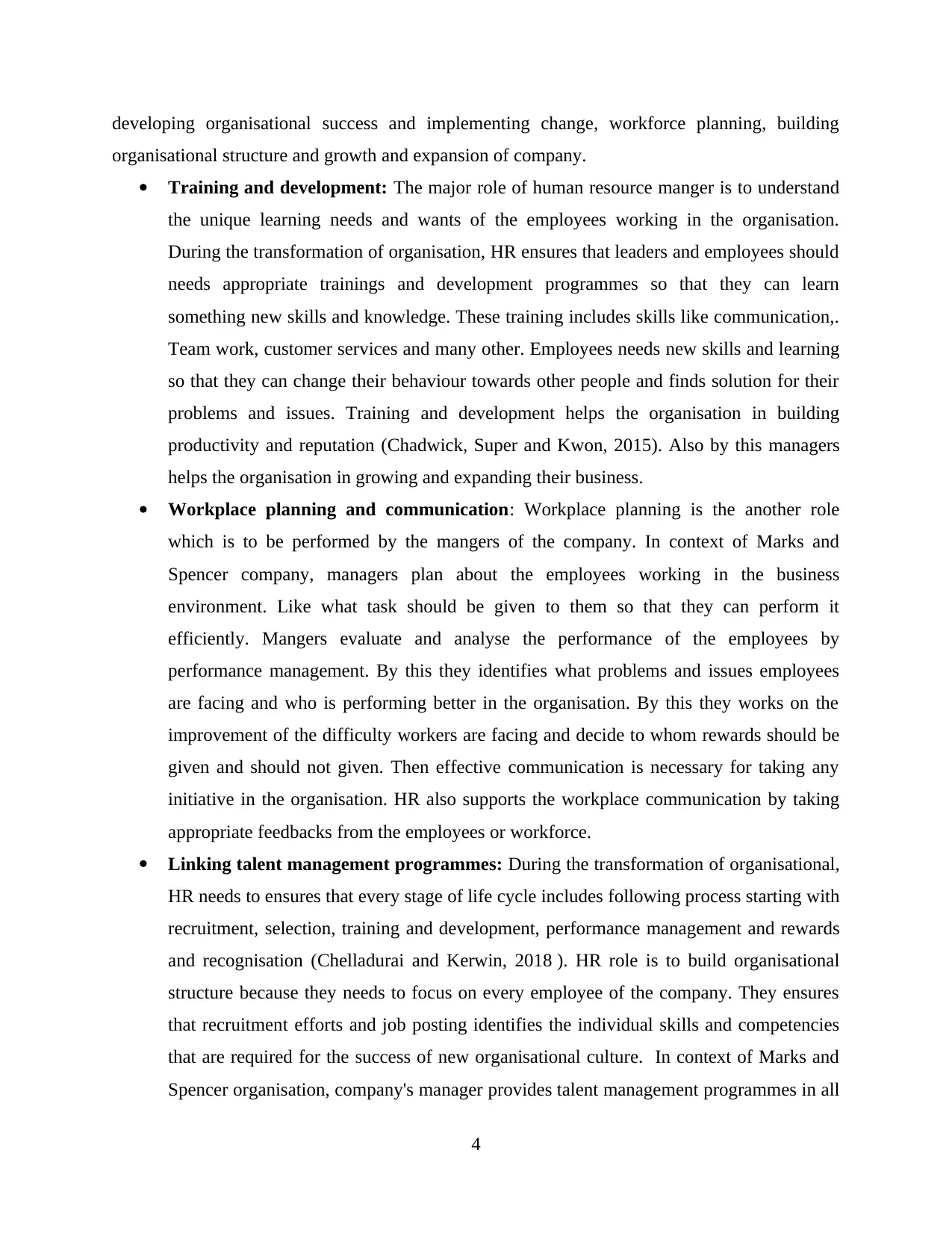
developing organisational success and implementing change, workforce planning, building
organisational structure and growth and expansion of company.
Training and development: The major role of human resource manger is to understand
the unique learning needs and wants of the employees working in the organisation.
During the transformation of organisation, HR ensures that leaders and employees should
needs appropriate trainings and development programmes so that they can learn
something new skills and knowledge. These training includes skills like communication,.
Team work, customer services and many other. Employees needs new skills and learning
so that they can change their behaviour towards other people and finds solution for their
problems and issues. Training and development helps the organisation in building
productivity and reputation (Chadwick, Super and Kwon, 2015). Also by this managers
helps the organisation in growing and expanding their business.
Workplace planning and communication: Workplace planning is the another role
which is to be performed by the mangers of the company. In context of Marks and
Spencer company, managers plan about the employees working in the business
environment. Like what task should be given to them so that they can perform it
efficiently. Mangers evaluate and analyse the performance of the employees by
performance management. By this they identifies what problems and issues employees
are facing and who is performing better in the organisation. By this they works on the
improvement of the difficulty workers are facing and decide to whom rewards should be
given and should not given. Then effective communication is necessary for taking any
initiative in the organisation. HR also supports the workplace communication by taking
appropriate feedbacks from the employees or workforce.
Linking talent management programmes: During the transformation of organisational,
HR needs to ensures that every stage of life cycle includes following process starting with
recruitment, selection, training and development, performance management and rewards
and recognisation (Chelladurai and Kerwin, 2018 ). HR role is to build organisational
structure because they needs to focus on every employee of the company. They ensures
that recruitment efforts and job posting identifies the individual skills and competencies
that are required for the success of new organisational culture. In context of Marks and
Spencer organisation, company's manager provides talent management programmes in all
4
organisational structure and growth and expansion of company.
Training and development: The major role of human resource manger is to understand
the unique learning needs and wants of the employees working in the organisation.
During the transformation of organisation, HR ensures that leaders and employees should
needs appropriate trainings and development programmes so that they can learn
something new skills and knowledge. These training includes skills like communication,.
Team work, customer services and many other. Employees needs new skills and learning
so that they can change their behaviour towards other people and finds solution for their
problems and issues. Training and development helps the organisation in building
productivity and reputation (Chadwick, Super and Kwon, 2015). Also by this managers
helps the organisation in growing and expanding their business.
Workplace planning and communication: Workplace planning is the another role
which is to be performed by the mangers of the company. In context of Marks and
Spencer company, managers plan about the employees working in the business
environment. Like what task should be given to them so that they can perform it
efficiently. Mangers evaluate and analyse the performance of the employees by
performance management. By this they identifies what problems and issues employees
are facing and who is performing better in the organisation. By this they works on the
improvement of the difficulty workers are facing and decide to whom rewards should be
given and should not given. Then effective communication is necessary for taking any
initiative in the organisation. HR also supports the workplace communication by taking
appropriate feedbacks from the employees or workforce.
Linking talent management programmes: During the transformation of organisational,
HR needs to ensures that every stage of life cycle includes following process starting with
recruitment, selection, training and development, performance management and rewards
and recognisation (Chelladurai and Kerwin, 2018 ). HR role is to build organisational
structure because they needs to focus on every employee of the company. They ensures
that recruitment efforts and job posting identifies the individual skills and competencies
that are required for the success of new organisational culture. In context of Marks and
Spencer organisation, company's manager provides talent management programmes in all
4
Paraphrase This Document
Need a fresh take? Get an instant paraphrase of this document with our AI Paraphraser

the employees. This helps them in building their skills and capabilities and make
decisions accordingly.
Organisational development and design: Organizational development is the another
role of Human resources manger. As he is the one who develops all the rules and policies
of the company. He needs to make certain strategies that helps the organisation in
achieving its goals and objectives. Quantitative and qualitative analysis of the business
capabilities helps the business in achieving organisational goals and objectives. This can
done through job design, skills analysis and performance measures etc. Role of HR
manger is to implement change in certain plans and policies that are to be made by them
in previous time period. These changes are done according to the demands and needs of
the employees and working in an organisation. Also, change in management,
organisational structure and capabilities are according to the needs and demands of
external customers (Cleaver, 2017).
Mediator: Human resource manager act as a mediator in between superiors and
subordinates. Managers are the one who play a role of peace maker at the time of
disputes, conflicts between groups and individual management. They are one who work
on the development of a company looks forwards to the new talents who can bring new
opportunities and innovative ideas for the accomplishment of company goals and success
of an organisation. In Marks and Spencer company, managers change according to the
dynamic environment and neds and demands of the internal and external environment.
Managers of a company act as a mediator between employees and board of directors.
Developing skills for the future: Managers and HR professionals work together to
develop workers skills and capabilities. Like human resources manager take decisions on
how to assign employees or workers in different roles and responsibility in the
organisation. This helps the organisation in adapt successfully in the business
environment. In Marks and Spencer company, employees shifted around various business
functions based on the priorities and employees preferences. Mangers develops plans and
standards that needs to be followed by workforce (Dubin, 2017).
These roles and responsibilities are performed by the Human resource manager in Marks
and Spencer. There responsibility is to provide training and development sessions to employees
and recruit new talents for the company so that they bring new innovative ideas and results in
5
decisions accordingly.
Organisational development and design: Organizational development is the another
role of Human resources manger. As he is the one who develops all the rules and policies
of the company. He needs to make certain strategies that helps the organisation in
achieving its goals and objectives. Quantitative and qualitative analysis of the business
capabilities helps the business in achieving organisational goals and objectives. This can
done through job design, skills analysis and performance measures etc. Role of HR
manger is to implement change in certain plans and policies that are to be made by them
in previous time period. These changes are done according to the demands and needs of
the employees and working in an organisation. Also, change in management,
organisational structure and capabilities are according to the needs and demands of
external customers (Cleaver, 2017).
Mediator: Human resource manager act as a mediator in between superiors and
subordinates. Managers are the one who play a role of peace maker at the time of
disputes, conflicts between groups and individual management. They are one who work
on the development of a company looks forwards to the new talents who can bring new
opportunities and innovative ideas for the accomplishment of company goals and success
of an organisation. In Marks and Spencer company, managers change according to the
dynamic environment and neds and demands of the internal and external environment.
Managers of a company act as a mediator between employees and board of directors.
Developing skills for the future: Managers and HR professionals work together to
develop workers skills and capabilities. Like human resources manager take decisions on
how to assign employees or workers in different roles and responsibility in the
organisation. This helps the organisation in adapt successfully in the business
environment. In Marks and Spencer company, employees shifted around various business
functions based on the priorities and employees preferences. Mangers develops plans and
standards that needs to be followed by workforce (Dubin, 2017).
These roles and responsibilities are performed by the Human resource manager in Marks
and Spencer. There responsibility is to provide training and development sessions to employees
and recruit new talents for the company so that they bring new innovative ideas and results in
5
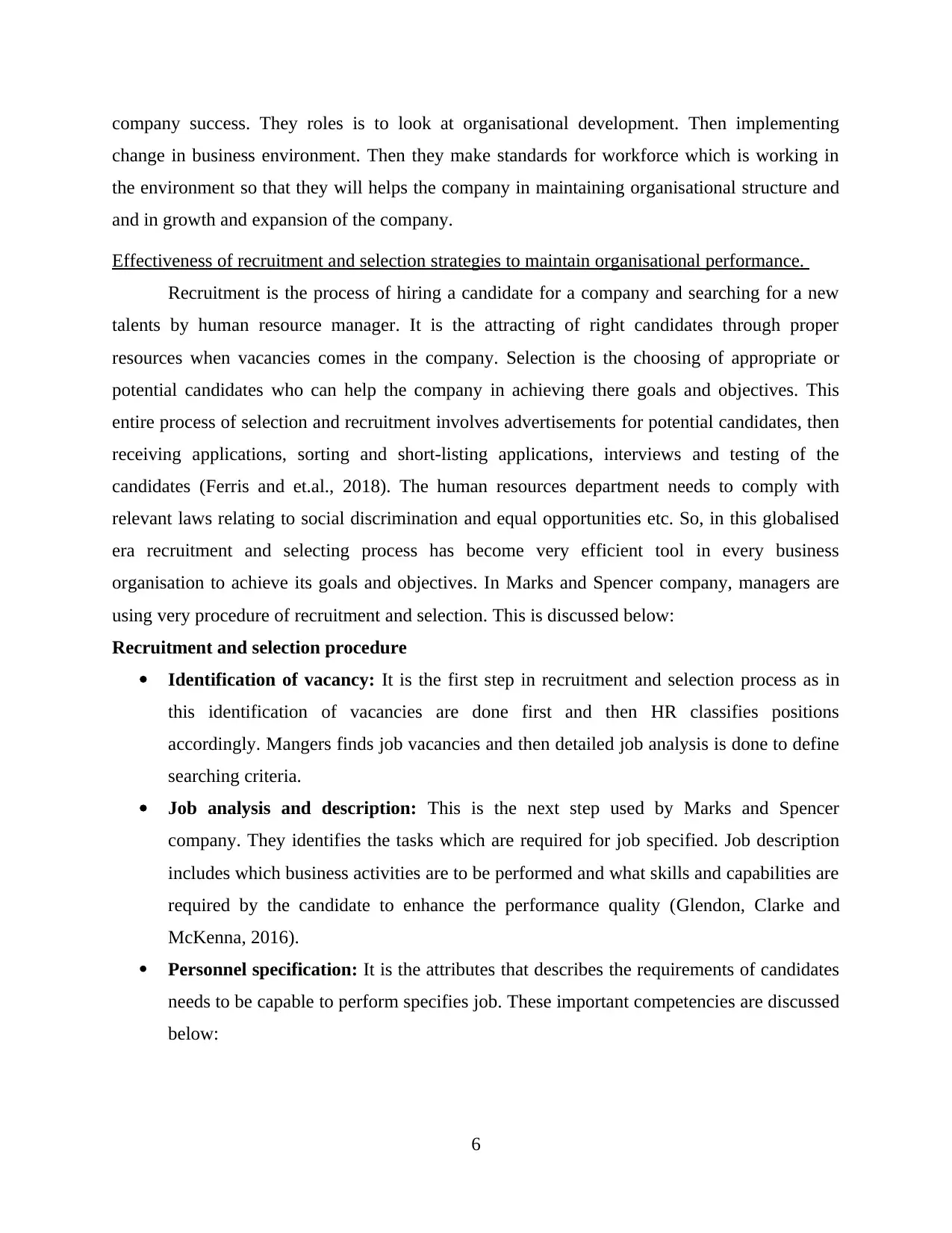
company success. They roles is to look at organisational development. Then implementing
change in business environment. Then they make standards for workforce which is working in
the environment so that they will helps the company in maintaining organisational structure and
and in growth and expansion of the company.
Effectiveness of recruitment and selection strategies to maintain organisational performance.
Recruitment is the process of hiring a candidate for a company and searching for a new
talents by human resource manager. It is the attracting of right candidates through proper
resources when vacancies comes in the company. Selection is the choosing of appropriate or
potential candidates who can help the company in achieving there goals and objectives. This
entire process of selection and recruitment involves advertisements for potential candidates, then
receiving applications, sorting and short-listing applications, interviews and testing of the
candidates (Ferris and et.al., 2018). The human resources department needs to comply with
relevant laws relating to social discrimination and equal opportunities etc. So, in this globalised
era recruitment and selecting process has become very efficient tool in every business
organisation to achieve its goals and objectives. In Marks and Spencer company, managers are
using very procedure of recruitment and selection. This is discussed below:
Recruitment and selection procedure
Identification of vacancy: It is the first step in recruitment and selection process as in
this identification of vacancies are done first and then HR classifies positions
accordingly. Mangers finds job vacancies and then detailed job analysis is done to define
searching criteria.
Job analysis and description: This is the next step used by Marks and Spencer
company. They identifies the tasks which are required for job specified. Job description
includes which business activities are to be performed and what skills and capabilities are
required by the candidate to enhance the performance quality (Glendon, Clarke and
McKenna, 2016).
Personnel specification: It is the attributes that describes the requirements of candidates
needs to be capable to perform specifies job. These important competencies are discussed
below:
6
change in business environment. Then they make standards for workforce which is working in
the environment so that they will helps the company in maintaining organisational structure and
and in growth and expansion of the company.
Effectiveness of recruitment and selection strategies to maintain organisational performance.
Recruitment is the process of hiring a candidate for a company and searching for a new
talents by human resource manager. It is the attracting of right candidates through proper
resources when vacancies comes in the company. Selection is the choosing of appropriate or
potential candidates who can help the company in achieving there goals and objectives. This
entire process of selection and recruitment involves advertisements for potential candidates, then
receiving applications, sorting and short-listing applications, interviews and testing of the
candidates (Ferris and et.al., 2018). The human resources department needs to comply with
relevant laws relating to social discrimination and equal opportunities etc. So, in this globalised
era recruitment and selecting process has become very efficient tool in every business
organisation to achieve its goals and objectives. In Marks and Spencer company, managers are
using very procedure of recruitment and selection. This is discussed below:
Recruitment and selection procedure
Identification of vacancy: It is the first step in recruitment and selection process as in
this identification of vacancies are done first and then HR classifies positions
accordingly. Mangers finds job vacancies and then detailed job analysis is done to define
searching criteria.
Job analysis and description: This is the next step used by Marks and Spencer
company. They identifies the tasks which are required for job specified. Job description
includes which business activities are to be performed and what skills and capabilities are
required by the candidate to enhance the performance quality (Glendon, Clarke and
McKenna, 2016).
Personnel specification: It is the attributes that describes the requirements of candidates
needs to be capable to perform specifies job. These important competencies are discussed
below:
6
⊘ This is a preview!⊘
Do you want full access?
Subscribe today to unlock all pages.

Trusted by 1+ million students worldwide
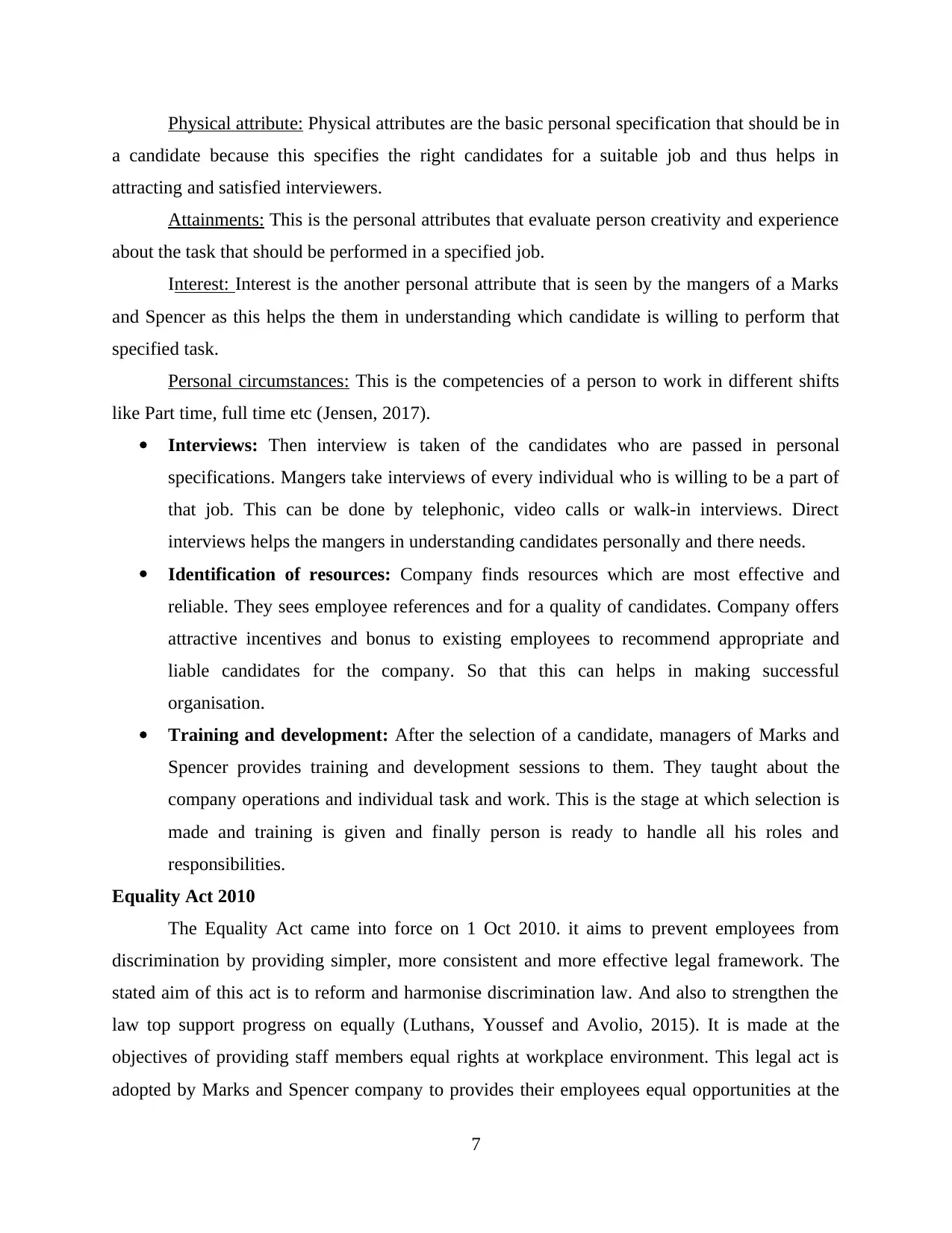
Physical attribute: Physical attributes are the basic personal specification that should be in
a candidate because this specifies the right candidates for a suitable job and thus helps in
attracting and satisfied interviewers.
Attainments: This is the personal attributes that evaluate person creativity and experience
about the task that should be performed in a specified job.
Interest: Interest is the another personal attribute that is seen by the mangers of a Marks
and Spencer as this helps the them in understanding which candidate is willing to perform that
specified task.
Personal circumstances: This is the competencies of a person to work in different shifts
like Part time, full time etc (Jensen, 2017).
Interviews: Then interview is taken of the candidates who are passed in personal
specifications. Mangers take interviews of every individual who is willing to be a part of
that job. This can be done by telephonic, video calls or walk-in interviews. Direct
interviews helps the mangers in understanding candidates personally and there needs.
Identification of resources: Company finds resources which are most effective and
reliable. They sees employee references and for a quality of candidates. Company offers
attractive incentives and bonus to existing employees to recommend appropriate and
liable candidates for the company. So that this can helps in making successful
organisation.
Training and development: After the selection of a candidate, managers of Marks and
Spencer provides training and development sessions to them. They taught about the
company operations and individual task and work. This is the stage at which selection is
made and training is given and finally person is ready to handle all his roles and
responsibilities.
Equality Act 2010
The Equality Act came into force on 1 Oct 2010. it aims to prevent employees from
discrimination by providing simpler, more consistent and more effective legal framework. The
stated aim of this act is to reform and harmonise discrimination law. And also to strengthen the
law top support progress on equally (Luthans, Youssef and Avolio, 2015). It is made at the
objectives of providing staff members equal rights at workplace environment. This legal act is
adopted by Marks and Spencer company to provides their employees equal opportunities at the
7
a candidate because this specifies the right candidates for a suitable job and thus helps in
attracting and satisfied interviewers.
Attainments: This is the personal attributes that evaluate person creativity and experience
about the task that should be performed in a specified job.
Interest: Interest is the another personal attribute that is seen by the mangers of a Marks
and Spencer as this helps the them in understanding which candidate is willing to perform that
specified task.
Personal circumstances: This is the competencies of a person to work in different shifts
like Part time, full time etc (Jensen, 2017).
Interviews: Then interview is taken of the candidates who are passed in personal
specifications. Mangers take interviews of every individual who is willing to be a part of
that job. This can be done by telephonic, video calls or walk-in interviews. Direct
interviews helps the mangers in understanding candidates personally and there needs.
Identification of resources: Company finds resources which are most effective and
reliable. They sees employee references and for a quality of candidates. Company offers
attractive incentives and bonus to existing employees to recommend appropriate and
liable candidates for the company. So that this can helps in making successful
organisation.
Training and development: After the selection of a candidate, managers of Marks and
Spencer provides training and development sessions to them. They taught about the
company operations and individual task and work. This is the stage at which selection is
made and training is given and finally person is ready to handle all his roles and
responsibilities.
Equality Act 2010
The Equality Act came into force on 1 Oct 2010. it aims to prevent employees from
discrimination by providing simpler, more consistent and more effective legal framework. The
stated aim of this act is to reform and harmonise discrimination law. And also to strengthen the
law top support progress on equally (Luthans, Youssef and Avolio, 2015). It is made at the
objectives of providing staff members equal rights at workplace environment. This legal act is
adopted by Marks and Spencer company to provides their employees equal opportunities at the
7
Paraphrase This Document
Need a fresh take? Get an instant paraphrase of this document with our AI Paraphraser
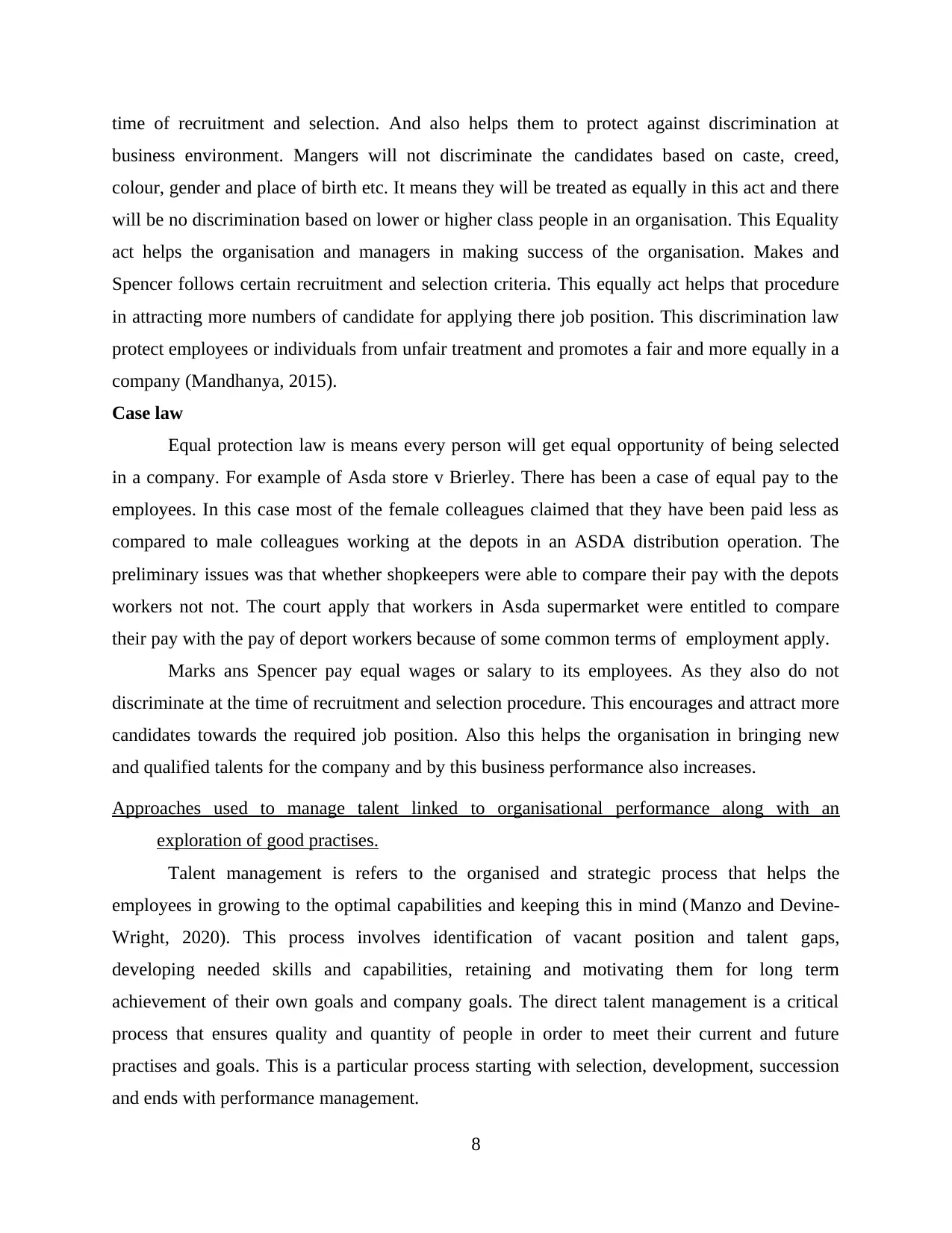
time of recruitment and selection. And also helps them to protect against discrimination at
business environment. Mangers will not discriminate the candidates based on caste, creed,
colour, gender and place of birth etc. It means they will be treated as equally in this act and there
will be no discrimination based on lower or higher class people in an organisation. This Equality
act helps the organisation and managers in making success of the organisation. Makes and
Spencer follows certain recruitment and selection criteria. This equally act helps that procedure
in attracting more numbers of candidate for applying there job position. This discrimination law
protect employees or individuals from unfair treatment and promotes a fair and more equally in a
company (Mandhanya, 2015).
Case law
Equal protection law is means every person will get equal opportunity of being selected
in a company. For example of Asda store v Brierley. There has been a case of equal pay to the
employees. In this case most of the female colleagues claimed that they have been paid less as
compared to male colleagues working at the depots in an ASDA distribution operation. The
preliminary issues was that whether shopkeepers were able to compare their pay with the depots
workers not not. The court apply that workers in Asda supermarket were entitled to compare
their pay with the pay of deport workers because of some common terms of employment apply.
Marks ans Spencer pay equal wages or salary to its employees. As they also do not
discriminate at the time of recruitment and selection procedure. This encourages and attract more
candidates towards the required job position. Also this helps the organisation in bringing new
and qualified talents for the company and by this business performance also increases.
Approaches used to manage talent linked to organisational performance along with an
exploration of good practises.
Talent management is refers to the organised and strategic process that helps the
employees in growing to the optimal capabilities and keeping this in mind (Manzo and Devine-
Wright, 2020). This process involves identification of vacant position and talent gaps,
developing needed skills and capabilities, retaining and motivating them for long term
achievement of their own goals and company goals. The direct talent management is a critical
process that ensures quality and quantity of people in order to meet their current and future
practises and goals. This is a particular process starting with selection, development, succession
and ends with performance management.
8
business environment. Mangers will not discriminate the candidates based on caste, creed,
colour, gender and place of birth etc. It means they will be treated as equally in this act and there
will be no discrimination based on lower or higher class people in an organisation. This Equality
act helps the organisation and managers in making success of the organisation. Makes and
Spencer follows certain recruitment and selection criteria. This equally act helps that procedure
in attracting more numbers of candidate for applying there job position. This discrimination law
protect employees or individuals from unfair treatment and promotes a fair and more equally in a
company (Mandhanya, 2015).
Case law
Equal protection law is means every person will get equal opportunity of being selected
in a company. For example of Asda store v Brierley. There has been a case of equal pay to the
employees. In this case most of the female colleagues claimed that they have been paid less as
compared to male colleagues working at the depots in an ASDA distribution operation. The
preliminary issues was that whether shopkeepers were able to compare their pay with the depots
workers not not. The court apply that workers in Asda supermarket were entitled to compare
their pay with the pay of deport workers because of some common terms of employment apply.
Marks ans Spencer pay equal wages or salary to its employees. As they also do not
discriminate at the time of recruitment and selection procedure. This encourages and attract more
candidates towards the required job position. Also this helps the organisation in bringing new
and qualified talents for the company and by this business performance also increases.
Approaches used to manage talent linked to organisational performance along with an
exploration of good practises.
Talent management is refers to the organised and strategic process that helps the
employees in growing to the optimal capabilities and keeping this in mind (Manzo and Devine-
Wright, 2020). This process involves identification of vacant position and talent gaps,
developing needed skills and capabilities, retaining and motivating them for long term
achievement of their own goals and company goals. The direct talent management is a critical
process that ensures quality and quantity of people in order to meet their current and future
practises and goals. This is a particular process starting with selection, development, succession
and ends with performance management.
8
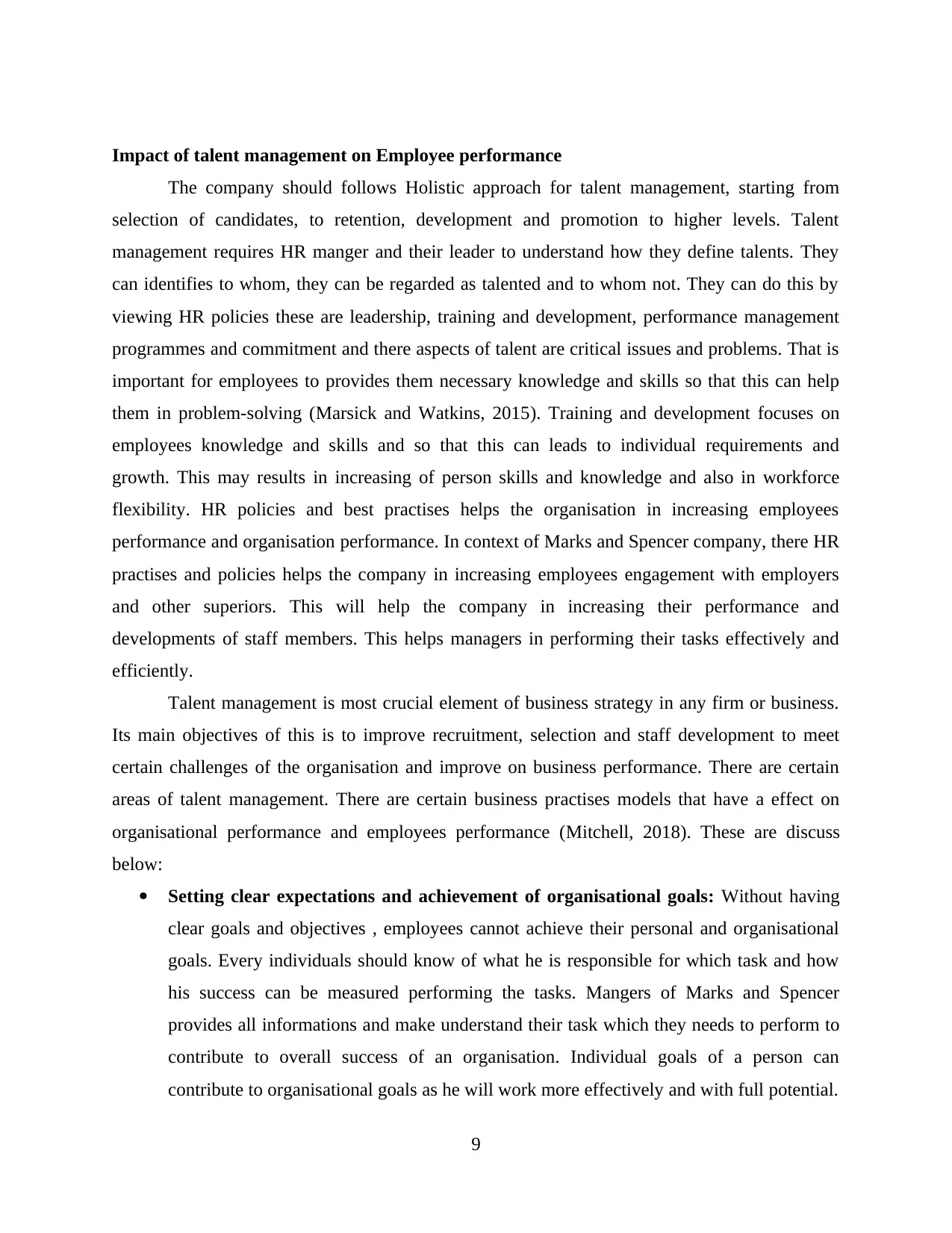
Impact of talent management on Employee performance
The company should follows Holistic approach for talent management, starting from
selection of candidates, to retention, development and promotion to higher levels. Talent
management requires HR manger and their leader to understand how they define talents. They
can identifies to whom, they can be regarded as talented and to whom not. They can do this by
viewing HR policies these are leadership, training and development, performance management
programmes and commitment and there aspects of talent are critical issues and problems. That is
important for employees to provides them necessary knowledge and skills so that this can help
them in problem-solving (Marsick and Watkins, 2015). Training and development focuses on
employees knowledge and skills and so that this can leads to individual requirements and
growth. This may results in increasing of person skills and knowledge and also in workforce
flexibility. HR policies and best practises helps the organisation in increasing employees
performance and organisation performance. In context of Marks and Spencer company, there HR
practises and policies helps the company in increasing employees engagement with employers
and other superiors. This will help the company in increasing their performance and
developments of staff members. This helps managers in performing their tasks effectively and
efficiently.
Talent management is most crucial element of business strategy in any firm or business.
Its main objectives of this is to improve recruitment, selection and staff development to meet
certain challenges of the organisation and improve on business performance. There are certain
areas of talent management. There are certain business practises models that have a effect on
organisational performance and employees performance (Mitchell, 2018). These are discuss
below:
Setting clear expectations and achievement of organisational goals: Without having
clear goals and objectives , employees cannot achieve their personal and organisational
goals. Every individuals should know of what he is responsible for which task and how
his success can be measured performing the tasks. Mangers of Marks and Spencer
provides all informations and make understand their task which they needs to perform to
contribute to overall success of an organisation. Individual goals of a person can
contribute to organisational goals as he will work more effectively and with full potential.
9
The company should follows Holistic approach for talent management, starting from
selection of candidates, to retention, development and promotion to higher levels. Talent
management requires HR manger and their leader to understand how they define talents. They
can identifies to whom, they can be regarded as talented and to whom not. They can do this by
viewing HR policies these are leadership, training and development, performance management
programmes and commitment and there aspects of talent are critical issues and problems. That is
important for employees to provides them necessary knowledge and skills so that this can help
them in problem-solving (Marsick and Watkins, 2015). Training and development focuses on
employees knowledge and skills and so that this can leads to individual requirements and
growth. This may results in increasing of person skills and knowledge and also in workforce
flexibility. HR policies and best practises helps the organisation in increasing employees
performance and organisation performance. In context of Marks and Spencer company, there HR
practises and policies helps the company in increasing employees engagement with employers
and other superiors. This will help the company in increasing their performance and
developments of staff members. This helps managers in performing their tasks effectively and
efficiently.
Talent management is most crucial element of business strategy in any firm or business.
Its main objectives of this is to improve recruitment, selection and staff development to meet
certain challenges of the organisation and improve on business performance. There are certain
areas of talent management. There are certain business practises models that have a effect on
organisational performance and employees performance (Mitchell, 2018). These are discuss
below:
Setting clear expectations and achievement of organisational goals: Without having
clear goals and objectives , employees cannot achieve their personal and organisational
goals. Every individuals should know of what he is responsible for which task and how
his success can be measured performing the tasks. Mangers of Marks and Spencer
provides all informations and make understand their task which they needs to perform to
contribute to overall success of an organisation. Individual goals of a person can
contribute to organisational goals as he will work more effectively and with full potential.
9
⊘ This is a preview!⊘
Do you want full access?
Subscribe today to unlock all pages.

Trusted by 1+ million students worldwide

Provide professional development opportunities: The major challenge for a company
is to develop workforce planning and succession management. Companies should
implement learning management system (LMS). This will employees in grooming and
interacting with other people. This will build a talent pool of high potential employees
that can fill vacant roles. Organisations that provide learning on the basis of performance
reviews, sees 38 percent of growth in their better engagement and interactions.
Measure and improve talent management: Company analyse and measures HR data
that can identify demand and supply trends, assessment of risk and uncover opportunities.
From performance and learning management to employee engagement, talent
management allows employees to share their content and data and develop skills and
knowledge (Morris, 2015).
Regular performance appraisal: Regular performance appraisal programmes are
carried out by managers of Marks and Spencer. Performance appraisal is the process of
evaluating and analysing the performance of employees and workers. In this mangers
identifies issues and problems that can be faced by workers working in an environment.
By this mangers can evaluate which employee is performing better and which not.
According to this basis, managers provide rewards and recognisation to employees and
workers for their better performance and provides training an development sessions to
those who are not performing their task efficiently and effectively.
Talent management is helps the HR manger in achieving their goals and organisational
objectives. There are certain benefits of talent management that helps on organisational
performance and individuals performance. These are discussed below:
Employee development: Talent management helps the employees in developing their
skills and capabilities, there learning and development needs. This develops employees
and staff members capabilities. And hence, results in benefiting a company and achieving
their goals and objectives (Moutinho and Vargas-Sanchez, 2018).
Increase employee and employers engagement: Talent management help employees in
interacting and making communication with their employers and leaders. Talent
management encourages employees to invest in the organisation and focus on business
goals and personal goals.
10
is to develop workforce planning and succession management. Companies should
implement learning management system (LMS). This will employees in grooming and
interacting with other people. This will build a talent pool of high potential employees
that can fill vacant roles. Organisations that provide learning on the basis of performance
reviews, sees 38 percent of growth in their better engagement and interactions.
Measure and improve talent management: Company analyse and measures HR data
that can identify demand and supply trends, assessment of risk and uncover opportunities.
From performance and learning management to employee engagement, talent
management allows employees to share their content and data and develop skills and
knowledge (Morris, 2015).
Regular performance appraisal: Regular performance appraisal programmes are
carried out by managers of Marks and Spencer. Performance appraisal is the process of
evaluating and analysing the performance of employees and workers. In this mangers
identifies issues and problems that can be faced by workers working in an environment.
By this mangers can evaluate which employee is performing better and which not.
According to this basis, managers provide rewards and recognisation to employees and
workers for their better performance and provides training an development sessions to
those who are not performing their task efficiently and effectively.
Talent management is helps the HR manger in achieving their goals and organisational
objectives. There are certain benefits of talent management that helps on organisational
performance and individuals performance. These are discussed below:
Employee development: Talent management helps the employees in developing their
skills and capabilities, there learning and development needs. This develops employees
and staff members capabilities. And hence, results in benefiting a company and achieving
their goals and objectives (Moutinho and Vargas-Sanchez, 2018).
Increase employee and employers engagement: Talent management help employees in
interacting and making communication with their employers and leaders. Talent
management encourages employees to invest in the organisation and focus on business
goals and personal goals.
10
Paraphrase This Document
Need a fresh take? Get an instant paraphrase of this document with our AI Paraphraser
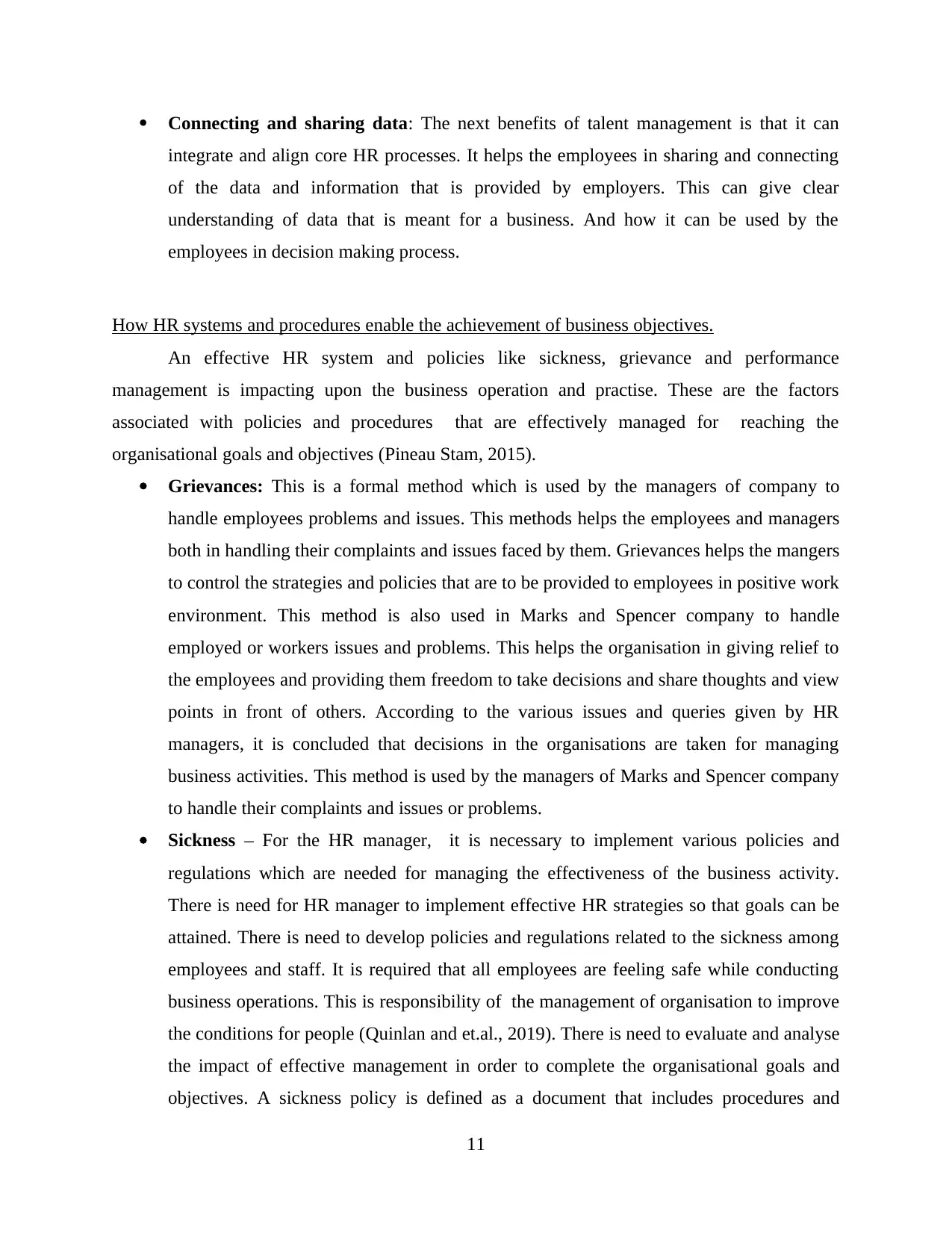
Connecting and sharing data: The next benefits of talent management is that it can
integrate and align core HR processes. It helps the employees in sharing and connecting
of the data and information that is provided by employers. This can give clear
understanding of data that is meant for a business. And how it can be used by the
employees in decision making process.
How HR systems and procedures enable the achievement of business objectives.
An effective HR system and policies like sickness, grievance and performance
management is impacting upon the business operation and practise. These are the factors
associated with policies and procedures that are effectively managed for reaching the
organisational goals and objectives (Pineau Stam, 2015).
Grievances: This is a formal method which is used by the managers of company to
handle employees problems and issues. This methods helps the employees and managers
both in handling their complaints and issues faced by them. Grievances helps the mangers
to control the strategies and policies that are to be provided to employees in positive work
environment. This method is also used in Marks and Spencer company to handle
employed or workers issues and problems. This helps the organisation in giving relief to
the employees and providing them freedom to take decisions and share thoughts and view
points in front of others. According to the various issues and queries given by HR
managers, it is concluded that decisions in the organisations are taken for managing
business activities. This method is used by the managers of Marks and Spencer company
to handle their complaints and issues or problems.
Sickness – For the HR manager, it is necessary to implement various policies and
regulations which are needed for managing the effectiveness of the business activity.
There is need for HR manager to implement effective HR strategies so that goals can be
attained. There is need to develop policies and regulations related to the sickness among
employees and staff. It is required that all employees are feeling safe while conducting
business operations. This is responsibility of the management of organisation to improve
the conditions for people (Quinlan and et.al., 2019). There is need to evaluate and analyse
the impact of effective management in order to complete the organisational goals and
objectives. A sickness policy is defined as a document that includes procedures and
11
integrate and align core HR processes. It helps the employees in sharing and connecting
of the data and information that is provided by employers. This can give clear
understanding of data that is meant for a business. And how it can be used by the
employees in decision making process.
How HR systems and procedures enable the achievement of business objectives.
An effective HR system and policies like sickness, grievance and performance
management is impacting upon the business operation and practise. These are the factors
associated with policies and procedures that are effectively managed for reaching the
organisational goals and objectives (Pineau Stam, 2015).
Grievances: This is a formal method which is used by the managers of company to
handle employees problems and issues. This methods helps the employees and managers
both in handling their complaints and issues faced by them. Grievances helps the mangers
to control the strategies and policies that are to be provided to employees in positive work
environment. This method is also used in Marks and Spencer company to handle
employed or workers issues and problems. This helps the organisation in giving relief to
the employees and providing them freedom to take decisions and share thoughts and view
points in front of others. According to the various issues and queries given by HR
managers, it is concluded that decisions in the organisations are taken for managing
business activities. This method is used by the managers of Marks and Spencer company
to handle their complaints and issues or problems.
Sickness – For the HR manager, it is necessary to implement various policies and
regulations which are needed for managing the effectiveness of the business activity.
There is need for HR manager to implement effective HR strategies so that goals can be
attained. There is need to develop policies and regulations related to the sickness among
employees and staff. It is required that all employees are feeling safe while conducting
business operations. This is responsibility of the management of organisation to improve
the conditions for people (Quinlan and et.al., 2019). There is need to evaluate and analyse
the impact of effective management in order to complete the organisational goals and
objectives. A sickness policy is defined as a document that includes procedures and
11
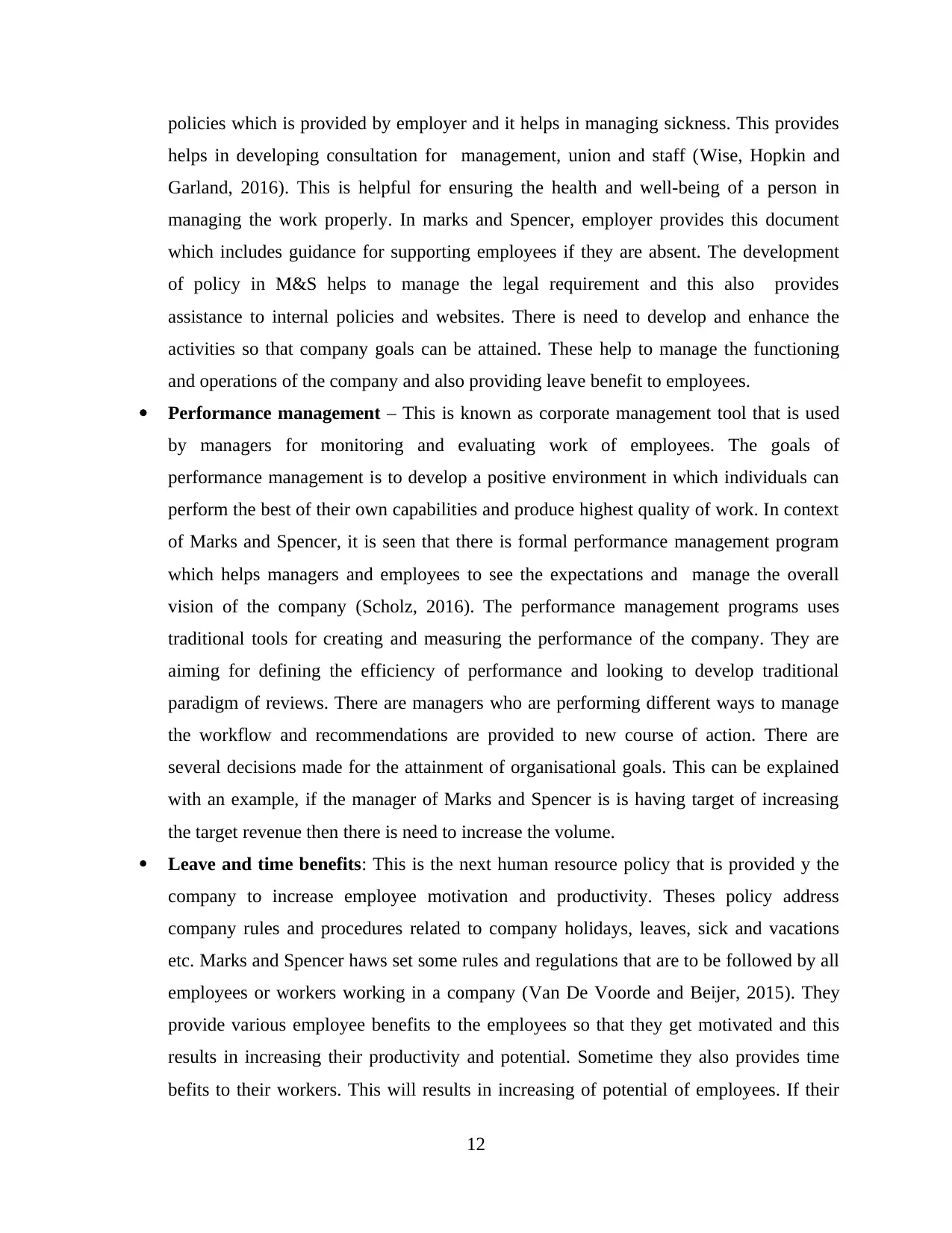
policies which is provided by employer and it helps in managing sickness. This provides
helps in developing consultation for management, union and staff (Wise, Hopkin and
Garland, 2016). This is helpful for ensuring the health and well-being of a person in
managing the work properly. In marks and Spencer, employer provides this document
which includes guidance for supporting employees if they are absent. The development
of policy in M&S helps to manage the legal requirement and this also provides
assistance to internal policies and websites. There is need to develop and enhance the
activities so that company goals can be attained. These help to manage the functioning
and operations of the company and also providing leave benefit to employees.
Performance management – This is known as corporate management tool that is used
by managers for monitoring and evaluating work of employees. The goals of
performance management is to develop a positive environment in which individuals can
perform the best of their own capabilities and produce highest quality of work. In context
of Marks and Spencer, it is seen that there is formal performance management program
which helps managers and employees to see the expectations and manage the overall
vision of the company (Scholz, 2016). The performance management programs uses
traditional tools for creating and measuring the performance of the company. They are
aiming for defining the efficiency of performance and looking to develop traditional
paradigm of reviews. There are managers who are performing different ways to manage
the workflow and recommendations are provided to new course of action. There are
several decisions made for the attainment of organisational goals. This can be explained
with an example, if the manager of Marks and Spencer is is having target of increasing
the target revenue then there is need to increase the volume.
Leave and time benefits: This is the next human resource policy that is provided y the
company to increase employee motivation and productivity. Theses policy address
company rules and procedures related to company holidays, leaves, sick and vacations
etc. Marks and Spencer haws set some rules and regulations that are to be followed by all
employees or workers working in a company (Van De Voorde and Beijer, 2015). They
provide various employee benefits to the employees so that they get motivated and this
results in increasing their productivity and potential. Sometime they also provides time
befits to their workers. This will results in increasing of potential of employees. If their
12
helps in developing consultation for management, union and staff (Wise, Hopkin and
Garland, 2016). This is helpful for ensuring the health and well-being of a person in
managing the work properly. In marks and Spencer, employer provides this document
which includes guidance for supporting employees if they are absent. The development
of policy in M&S helps to manage the legal requirement and this also provides
assistance to internal policies and websites. There is need to develop and enhance the
activities so that company goals can be attained. These help to manage the functioning
and operations of the company and also providing leave benefit to employees.
Performance management – This is known as corporate management tool that is used
by managers for monitoring and evaluating work of employees. The goals of
performance management is to develop a positive environment in which individuals can
perform the best of their own capabilities and produce highest quality of work. In context
of Marks and Spencer, it is seen that there is formal performance management program
which helps managers and employees to see the expectations and manage the overall
vision of the company (Scholz, 2016). The performance management programs uses
traditional tools for creating and measuring the performance of the company. They are
aiming for defining the efficiency of performance and looking to develop traditional
paradigm of reviews. There are managers who are performing different ways to manage
the workflow and recommendations are provided to new course of action. There are
several decisions made for the attainment of organisational goals. This can be explained
with an example, if the manager of Marks and Spencer is is having target of increasing
the target revenue then there is need to increase the volume.
Leave and time benefits: This is the next human resource policy that is provided y the
company to increase employee motivation and productivity. Theses policy address
company rules and procedures related to company holidays, leaves, sick and vacations
etc. Marks and Spencer haws set some rules and regulations that are to be followed by all
employees or workers working in a company (Van De Voorde and Beijer, 2015). They
provide various employee benefits to the employees so that they get motivated and this
results in increasing their productivity and potential. Sometime they also provides time
befits to their workers. This will results in increasing of potential of employees. If their
12
⊘ This is a preview!⊘
Do you want full access?
Subscribe today to unlock all pages.

Trusted by 1+ million students worldwide
1 out of 14
Related Documents
Your All-in-One AI-Powered Toolkit for Academic Success.
+13062052269
info@desklib.com
Available 24*7 on WhatsApp / Email
![[object Object]](/_next/static/media/star-bottom.7253800d.svg)
Unlock your academic potential
Copyright © 2020–2025 A2Z Services. All Rights Reserved. Developed and managed by ZUCOL.





